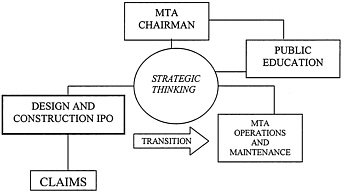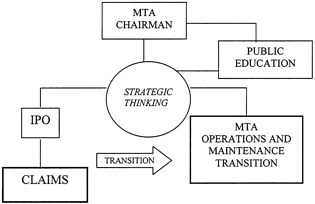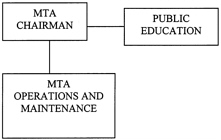6
Transition from Construction to Operations
USER TRANSITION
After a 20-year process of planning, designing, and constructing the CA/T project, the final major transition will be to operations and maintenance. The public, having long endured the project’s disruptions and inconveniences, now expects results—specifically that the new roadways will solve the old congestion problems, making hours of delay while stuck in traffic a thing of the past. But without careful planning, that “moment” could be traumatic. While the owner can grow with operations experience gained over time, users must adapt immediately as they traverse the new system. More than a third of the CA/T project is underground, where motorists do not have environmental factors to give them locational clues; they are totally dependent on the signs, stripes, and lighting along the roadway. Because these clues must be familiar and effective right from the beginning—the motorist’s first impression of the new system will likely be a lasting one—the job of communicating with the public cannot be neglected or left to the last minute.
Public Education
The public-education element of the start-up process is critical and should be a major focus of the transition team. If the owner assigns responsibility for it to a nontechnical individual or firm, a technical person will be absolutely necessary to review what is being presented and assure that it is user-friendly and consistent with the reality of the project.
The message should start early and be repeated often, virtually to the point where the public gets tired of hearing it. There is certainly a saturation point for information, but until then the population is slowly absorbing the news. A corollary is that innovative ways of getting the public’s attention are necessary, as most people filter information and consciously take in only what piques their interest. All forms of local media must therefore be engaged. Service clubs, auto clubs, neighborhood groups, and the Massachusetts Registry of Motor Vehicles can also help spread the word. And in addition to the average citizen, other important players—the enforcement community, the courts and judges, and traffic reporters—also need to be educated. Needless to say, the message content should be relevant and accurate right from the start.
Unfortunately, information supplied to the committee indicates that the MTA is substantially behind schedule in educating the public and preparing motorists for the new system, and this is a cause for concern. The committee believes that proper education of the users cannot happen with a sudden media “blitz” but will need a carefully planned and targeted stream of information executed well ahead of start-up.
Safety
The committee also believes that motorist safety will require special attention when the CA/T is opened. Because a large portion of the project is underground, with minimal shoulders for disabled vehicles, a stranded motorist may be placed in a hazardous position. The current operational procedures rely on cameras monitored in the Operations Control Center to spot troubled vehicles, and they allow up to 8 minutes to service the scene. During this time, the motorist in the tunnel may be confused, unaware of what is going on, and vulnerable. Guidance for such situations should be included in the public-education process in order to prevent these kinds of user reactions.
MANAGEMENT TRANSITION
The documentation that the committee received from the MTA contains extensive procedural guidance for the transition process. This guidance pertains to operations and maintenance responsibilities, transfer of ownership, safety certification, and the documentation required.
The process’s organization chart shows the MTA chief of operations serving as director of transition. It also indicates that 79 percent (72/91) of the transition staff are employees of B/PB. Meanwhile, existing parallel to the transition organization is the operations organization, with approximately 450 MTA employees. But the process by which the MTA will phase out the transition staff (plus the 600 staff working within the IPO) and phase in the operations staff is not clear.
Two important elements of the seemingly missing strategic link should be recognized:
-
Maintenance of the CA/T project’s institutional memory during transition will require the cooperation of all the organizations involved in design, construction, and operation.
-
Staff changes caused by transition and the time required to familiarize new staff members with management processes and administrative procedures can extend the transition schedule.
A Strategic Approach to Transition
The following three diagrams (Figures 6.1, 6.2, and 6.3) represent the perceived relationships between management functions at different stages of the project transition. They illustrate the relative changes in emphasis among the design and construction IPO, claims processing, and operations and maintenance. The diagrams also indicate the need for “strategic thinking” to coordinate the transition process within MTA and prepare the public to use the new highway system safely and efficiently.
“Strategic thinking” is a process for synthesizing and disseminating project information on scheduled openings, milestones, staffing levels, transition status, cost and schedule, risk, contingency budgets, project performance data, and any other data that affect the project goals. Effective communications among the dozens of federal, state, and local government agencies, as well as organizations representing private interests, need to be facilitated so that each is prepared to fulfill its role in completing and operating the CA/T system. The strategic-thinking process integrates all this information with a broad view of the project and determines the criticality and importance of individual elements. Because information flow is dynamic, the process needs to
be highly responsive to any new information. Most important, this function should be able to anticipate and prepare for the next scheduled milestone and, as much as possible, for unforeseen problems.

FIGURE 6.1 Transition Phase 1—Completing Construction

FIGURE 6.2 Transition Phase 2—Transition to O&M and Resolving Claims

FIGURE 6.3 Transition Phase 3—Operation of system
SECURITY
During the project field review, in October 2002, the committee perceived a lack of security for the CA/T project sites. In these times of heightened need for critical-infrastructure protection, CA/T site security is essential. This should not be a problem, however, given that the available police force, provided to the MTA by the State Police, will double in size during the transition period as part of the operations provisions. By accelerating that increase, this resource could be used for construction-site security until the full demands of operating the CA/T are known.
FINDINGS AND RECOMMENDATIONS
Public Education
Finding 13: Information transfer to the motoring public has been minimal thus far and not well timed for the scheduled opening of the first completed sections of the project.
The committee saw little evidence of the type of media program necessary for preparing the public to use a new, complex, and possibly challenging highway system. The media-relations functions, which are based in the chairman’s office, do not have the technical guidance for helping to prepare the needed public information.
Recommendation 13: MTA should have a media team, with technical assistance provided by the project staff, to develop and immediately implement an innovative plan for educating the public to use the CA/T.
The training should include traffic patterns and procedures for normal operations as well as actions to be taken during accidents, breakdowns, and emergencies. The public-education plan should be an integral part of the strategic thinking for the transition of the project to MTA operations and maintenance.
Strategic Thinking
Finding 14: The committee has not seen an adequate plan for guiding the transition from a construction organization dominated by project-management consultants to an operations organization that is largely composed of full-time MTA staff.
The transition from design and construction of CA/T to its operations and maintenance will be a major challenge. The committee believes that the MTA currently lacks strategic thinking for managing this transition process.
Recommendation 14: The MTA should establish processes to assist its chairman in identifying and prioritizing strategic issues and in carrying out the transition from design and construction to operations and maintenance.
The MTA needs processes for responding to changing conditions. These processes should: 1) guide the phasing-out of the IPO; 2) close construction contracts; and 3) maintain controls while the MTA assumes responsibility for the CA/T.
Security
Finding 15: During its October site visit, the committee observed what it perceived as a lack of security.
The committee had signed in and carried credentials for its visit, but it appeared that open access was available at all project-access points. Furthermore, there was no evidence of a security-force presence anywhere in the project area.
Recommendation 15: A comprehensive security program should be developed, immediately implemented, and maintained not only until completion of the project but also throughout its transition to operation.
This would include requiring credentials for all personnel on-site as well as security control at all project-access points, consistent with recognized security practices. The resources of the State Police force assigned to the MTA should be considered for this task. More generally, the MTA should coordinate its efforts with those of the Department of Homeland Security for heightening the security of our nation’s infrastructure.





